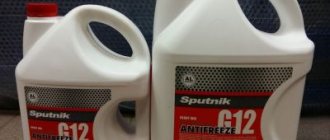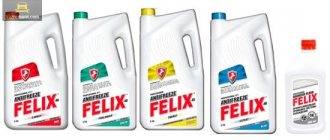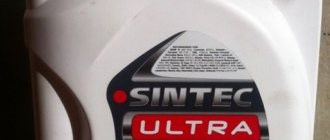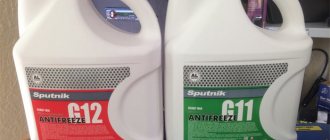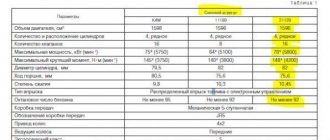Many car enthusiasts think about what kind of antifreeze is poured into the Lada Vesta from the factory only when it is time to change it or when it is necessary to urgently add coolant.
This is due to the fact that mixing antifreezes of different brands is not recommended, and those with different bases are generally prohibited. It is not recommended to fill the system with water (including distilled water), even in summer, since the coolant contains special additives that protect against corrosion. In addition, antifreeze contains lubricating components necessary for the water pump.
Engine oil
There are no “preferred” oils here anymore! All Vesta engines can be filled with any oil with API quality level SL or SM, as well as SN. The factory sets the viscosity parameters of the oil too wide. It is better to limit yourself to the following viscosity ranges depending on temperature:
| Minimum air temperature, °C | SAE viscosity grade | Maximum air temperature, °C |
| —40* | 0W-40 | 30 |
| —30 | 5W-30 | 25 |
| —30 | 5W-40 | 35 |
| —25 | 10W-30 | 25 |
| —25 | 10W-40 | 35 |
* Optimal oils for use in Russia are highlighted in bold.
If the temperature in your region is 40°C, then it makes sense to fill in 5W-50 type oils.
Requirements for antifreeze Lada Vesta
Antifreeze for Lada Vesta must have the following qualities:
— remove heat from the engine cylinders; - do not freeze at subzero temperatures; — do not form deposits inside the cooling system; — prevent the formation of rust; — do not cause damage to rubber parts; — do not foam during engine operation; - have the necessary lubricating properties.
As you may have noticed, the requirements for antifreeze on the Lada Vesta are not as few as it seems. And it’s not so easy to combine all these qualities in one liquid.
Antifreeze level Lada Vesta
The Lada Vesta antifreeze level must be monitored using marks on the expansion tank under the hood of the car. It is installed on the passenger side in the far corner of the engine compartment of the car and has the shape of a ball.
The tank indicates the minimum and maximum marks, as well as the type of liquid being filled. In our case it is G12. If there are no leaks in the cooling system and the engine has cooled down, the coolant level should be between the MIN and MAX marks. When the engine is warm, antifreeze expands and can reach its maximum level.
If the Lada Vesta antifreeze runs out and the level constantly drops, then you need to add coolant to the required amount and contact a specialized service. Factory antifreeze Lada Vesta has a special fluorescent additive that glows under ultraviolet light. Thanks to this, you can quickly determine the location of the coolant leak.
Lada Vesta: what kind of antifreeze is filled in from the factory?
From the factory, Sintec Antifreeze Lux G12 antifreeze is poured into the Lada Vesta car. It complies with TU 2422-047-51140047-2007. Antifreeze is red in color and is produced by Obninskorgsintez JSC in the city of Obninsk. Products of this brand are produced in volumes of 1, 3, 5, 10, 20 and 220 kg.
To order online you can use the following article numbers:
1kg - 613500 3kg - 990464 5kg - 614500 10kg - 756665 20l - 990470
And now a few words about the antifreeze itself. Sintec Antifreeze Lux G12 is the latest carboxylate antifreeze based on an aqueous solution of glycol and organic additives. Does not contain nitrites, nitrates, amines, phosphates, borates and silicates. Since 2011, this product was chosen as the main one for the first refueling of LADA cars at the AvtoVAZ plant. In addition, it is recommended to use Sintec Antifreeze Lux G12 during warranty and post-warranty service of Lada vehicles.
Recommended analogues
“Native” lubricant is optimal for manual transmission. But the primary oil is changed even before the first oil change according to the regulations in the Lada Vesta manual transmission. Analogues are often selected:
- ZIC GFT 75W-85 - this serious development has undergone many laboratory tests. Synthetics are produced on the basis of hydrocarbon compounds polyalphaolefins (PAO) with the addition of sulfur and phosphorus impurities that counteract wear. To prevent lubricant particles from precipitating, boron is added. At 40 °C on the thermometer, the technical liquid thickens. According to the manufacturer’s recommendation, it should not be used at temperatures above 40 °C.
- Motul MotyLGear 75W-90 API GL5 is a non-foaming synthetic oil with a complex of extreme pressure additives and an improved formula for thermal-oxidative stability. The oil film remains unchanged on gearbox components at .45 °C.
- Total Dual 9FE 75W-90 API GL4 - synthetic lubricant hardens at.51 °C. The high viscosity index and homogeneous molecular structure make it possible to extend service intervals up to 180,000 km.
Elf Tranself NFJ 75w-80 (for very high load conditions), TM-4-12 SAE 76W-85 GL-4 (available in the boxes of all Tolyatti car modifications) also have excellent characteristics.
Coolant replacement
Antifreeze on Vesta needs to be replaced periodically, since it loses its properties over time, and insoluble particles may appear in it from the internal surfaces. Waste fluid increases wear on the pump's sliding bearing, which often leads to its failure. This is especially true for the engine jacket, inside of which it is technically difficult to remove scale.
Photo source: https://www.zr.ru/content/articles/852383-lada-vesta-instrukciya-po-zamene-oxlazhdayushhej-zhidkosti/2581/
When replacing coolant, it is important to use the recommended brand, observe replacement periods, and ensure compliance with technical operating conditions. Prices should not be taken into account, since even the most expensive composition will be cheaper than even minor CO repairs.
When is it time to change antifreeze?
You need to change antifreeze in a Lada Vesta or Cross after a mileage of 90 thousand km or 60 months of operation since the last replacement. The condition that occurred first is selected.
Fill with factory-recommended antifreeze with special additives designed to increase corrosion resistance.
Which antifreeze to choose for Lada Vesta
What antifreeze should I put in Vesta? AvtoVAZ allows the use of liquids only of class G12. In addition to antifreeze produced by Sintec, a number of analogues can be used:
- Cool Steam Premium or Standard;
- Felix Carbox;
- G-Energy Antefreexe;
- TC-Felix.
Photo source: https://www.zr.ru/content/articles/852383-lada-vesta-instrukciya-po-zamene-oxlazhdayushhej-zhidkosti/2581/
Original fluids from the Lada car manufacturer are suitable; their properties and color (yellow-pink) are the same as those produced by Sintec. Other compounds that have a quality certificate from AvtoVAZ are also permitted.
Is it possible to mix different coolants?
The development of antifreeze by manufacturers takes into account the technical characteristics, functional features of the lines used, pumps, radiators and other components. Their chemical compositions differ, so mixing may result in the formation of compounds whose effect on the cooling circuit is unknown.
It is difficult to predict the consequences of mixing several types of compounds in advance, even if the following conditions are met:
- matching liquid color;
- one manufacturer;
- one brand;
- identical characteristics of the compositions.
Compositions may differ between shipments as manufacturers strive to improve the properties of the coolant. In case of critical situations, you can add a similar composition, but after reaching the service station, you should completely replace the antifreeze.
Photo source: https://www.zr.ru/content/articles/852383-lada-vesta-instrukciya-po-zamene-oxlazhdayushhej-zhidkosti/2581/
Mixing is likely to cause serious damage to the CO, requiring costly repairs. Also, these actions will void the warranty on the car. Therefore, mixing antifreeze is strictly prohibited.
How to drain coolant from Vesta
Drain antifreeze or any other antifreeze in the following order:
- Drive the car onto the overpass.
- Wait until the engine cools down.
- Remove the protective plate from the power unit.
- Unscrew the 3 bolts securing the starter to the clutch housing and remove it. Access the drain screw.
- Place a 10 liter container under the radiator.
- Use a clamp to release the hose clamp (for a compression type) or unscrew a screwdriver (for a threaded type) on the radiator outlet to drain so that the liquid flows into a container.
- Unscrew the plug located on the cylinder block.
- Unscrew the expansion tank cap and increase the drain speed.
- After completing the procedure, install the parts in place.
After draining, fill in new antifreeze and make sure there are no leaks. The procedure is shown in more detail in the video.
How much antifreeze to pour into Vesta
The amount of coolant poured into the Lada Vesta at the factory is 7.84 liters. Therefore, for a complete replacement you need at least 8 liters. You will have to buy a canister of antifreeze, the volume of which is 10 liters, so that the remaining 2 liters can be used for topping up if the level drops.
Fill in antifreeze only when the engine is cool and not running, provided the system is sealed. The level should be maintained in the middle between two marks: minimum and maximum. When heated, the liquid expands and can therefore exceed the maximum level.
About the role of color
The color of the liquids emphasizes that they cannot be mixed with each other. Many believe that the color of the coolant is somehow related to its chemical formula. But this is a mistake.
The fact is that the color of antifreeze is given exclusively by a dye, which can be anything. It is not covered by the standards. Manufacturers give the recommended fluids a certain color in order to hammer into the consumer’s head a simple idea: our cars should not be filled with
whatever. The car owner sees that the counters of authorized dealers are indeed lined with canisters of liquids of the same color. This involuntarily evokes respect for factory requirements. Although in practice the effect is the opposite.
Identify carboxylate antifreeze
The driver still won’t be able to change from a hybrid or, say, lobrid, but he will be able to remember the required color.
But in the end, having refused the services of the officials, he automatically begins to look for antifreeze
in the usual color - say, red. And there are plenty of them on sale: in Russia, hundreds of companies and small companies are engaged in the production of coolant. Most of them are ready to change the color of their products even every day, as long as they take it. They're looking for red liquid - okay, tomorrow we'll paint everything red!
Nobody obliges you to coordinate the color of the liquids produced with other companies. As a result, having refused the services of the officials, the owner will almost certainly buy the “wrong” coolant. There will be no one to blame - the buyer is to blame.
Where to fill
The plug has been tightened, now we fill it into the system until the expansion tank is full. I recommend pouring in a thin stream to avoid air lock. Don't forget about the starter, put it in place. We filled the system with antifreeze, put the terminal in place, and started the car. While the power unit is operating, we begin to compress all the hoses several times. This approach will ensure good filling of the system and air outlet. We monitor the fluid level, as it may gradually drop. It all depends on the uniform filling of the system when filling liquid and the release of air. Fill to the set level. Do not forget to tighten the plug. Initially, with a cold engine, the lower pipe will be cold for the first minutes after starting, but as the engine warms up, it will begin to warm up and become hot - this means that the system is fully operational, the liquid flows in a large circle -. We are waiting for the fan to turn on. Then we checked all the pipes again to make sure they were hot. It’s better to make sure once again that the entire system is full and there are no plugs. We turn off the engine.
When it cools down, check the liquid level once and, if necessary, add to the required level. That's all, the cooling system has been successfully serviced.
Antifreeze for Lada Vesta needs to be replaced regularly to ensure proper operation of the engine cooling system. It is important to use high-quality coolant approved by the car manufacturer.
Antifreeze highly effectively removes heat from the internal combustion engine in any weather due to its high boiling point and resistance to negative temperatures. This coolant consists of water, ethylene glycol and additives that protect parts from corrosion and extend the life of the entire system.
For Lada Vesta, AvtoVAZ recommends using the same coolant that is poured into this model at the factory, namely Sintec Antifreeze Lux G12. Class G12 meets high quality standards, which is why it is highly appreciated by car manufacturers and is popular among car owners.
Sintec Antifreeze Lux G12 is made on the basis of ethylene glycol and carboxylates. It does not contain silicates, which eliminates the formation of sediment and improves the quality of heat removal compared to class G11. Sintec Antifreeze Lux G12 is painted red with an orange tint. Additives that are added to coolants of this class do not have a preventive anti-corrosion effect, however, they effectively isolate and neutralize foci of corrosion, preventing it from spreading.
Antifreeze Sintek g12
In order to achieve the most efficient operation of the cooling system, you should listen to the recommendations of AvtoVAZ.
What to replace it with?
What to do when adding antifreeze
necessary, but there are no conveyor brands at hand?
If you need to add no more than 200 ml, you should use distilled water: this is recommended not only by VAZ, but also by other automakers. It is strictly forbidden to add coolant of an unknown composition to the Lada, even if its color seemed “correct” to you. Additive packages in liquids made using different technologies stop working altogether when mixed. At the same time, they not only do not bring any benefit, but can also cause harm by precipitating. The operation of the stove and the entire cooling system will be disrupted.
If the car is already out of warranty and we are talking about adding a large volume of coolant, you will have to completely drain the old fluid and fill in new one. In this case, you should use a product from a serious manufacturer. Among domestic brands, let us remember such brands as Nord, Felix, Sintec and Coolstream. Before purchasing antifreeze, it makes sense to go to the website of the developer company and find out which product is the most modern. It is less likely to damage the engine. Neither the composition of the coolant, nor, especially, its color play a role in this.
- Modern technologies - additives in fuel and lubricants - will help extend the life of any mechanism.
